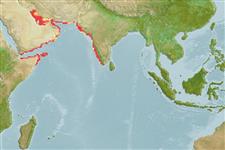Environment: milieu / climate zone / depth range / distribution range
Ecologia
marino demersale; distribuzione batimetrica 10 - 155 m (Ref. 89707). Tropical; 33°N - 8°N, 44°E - 77°E (Ref. 5222)
Western Indian Ocean: Gulf of Aden, Gulf of Oman, Persian Gulf, Pakistan, and west coast of India. Since it has only recently been discovered, it may be expected to have a wider distribution.
Size / Peso / Age
Maturity: Lm ? range ? - ? cm
Max length : 61.0 cm TL maschio/sesso non determinato; (Ref. 30573); 54.7 cm TL (female); peso massimo pubblicato: 0.00 g
Spine dorsali (totale) : 11; Raggi dorsali molli (totale) : 16 - 17; Spine anali: 3; Raggi anali molli: 8. Distinguished by the following characteristics: head, body and fins pale, covered with numerous small close-set dark brown spots; spots on fins and dorsal parts of head and body smaller and closer together compared to those on the sides and ventrally; rear edge of caudal fin with white line and a row of blackish brown spots; presence of dark maxillary streak; body depth contained 2.6-3.3 times in SL; body width 1.8-2.4 times in depth; head length 2.5-2.8 times in SL; slightly convex interorbital, dorsal head profile almost straight; angular preopercle, with indentation above the angle and enlarged serrae below the indentation; straight upper edge of operculum; posterior nostrils slightly larger than anterior ones; maxilla reaches to below rear half of eye; front of jaws with a pair of small fixed canines; 2 rows of teeth on midlateral part of lower jaw, inner ones twice length of outer teeth, pyloric caeca 28-34 (Ref. 89707).
Known from rocky areas adjacent to soft bottoms in depths 10-155 m (Ref. 89707). In the Hong Kong live fish markets (Ref. 27253).
Life cycle and mating behavior
Maturità | Riproduzione | Deposizione | Uova | Fecundity | Larve
Heemstra, P.C. and J.E. Randall, 1993. FAO Species Catalogue. Vol. 16. Groupers of the world (family Serranidae, subfamily Epinephelinae). An annotated and illustrated catalogue of the grouper, rockcod, hind, coral grouper and lyretail species known to date. Rome: FAO. FAO Fish. Synop. 125(16):382 p. (Ref. 5222)
IUCN Red List Status (Ref. 130435: Version 2024-2)
Threat to humans
Harmless
Human uses
Pesca: commerciale
Strumenti
Special reports
Download XML
Fonti Internet
Estimates based on models
Preferred temperature (Ref.
123201): 21.9 - 27.1, mean 24.5 °C (based on 133 cells).
Phylogenetic diversity index (Ref.
82804): PD
50 = 0.5000 [Uniqueness, from 0.5 = low to 2.0 = high].
Bayesian length-weight: a=0.01047 (0.00612 - 0.01792), b=3.02 (2.88 - 3.16), in cm total length, based on LWR estimates for this species & Genus-body shape (Ref.
93245).
Trophic level (Ref.
69278): 3.9 ±0.6 se; based on size and trophs of closest relatives
Generation time: 15.0 ( na - na) years. Estimated as median ln(3)/K based on 1
growth studies.
Resilienza (Ref.
120179): Medio, tempo minimo di raddoppiamento della popolazione 1.4 - 4.4 anni (K=0.19; tmax=41).
Fishing Vulnerability (Ref.
59153): High to very high vulnerability (67 of 100).
Nutrients (Ref.
124155): Calcium = 75.3 [33.2, 165.4] mg/100g; Iron = 0.879 [0.418, 2.024] mg/100g; Protein = 17.7 [16.1, 19.2] %; Omega3 = 0.212 [0.111, 0.389] g/100g; Selenium = 67.2 [32.7, 152.8] μg/100g; VitaminA = 45.3 [11.1, 177.2] μg/100g; Zinc = 1.21 [0.77, 1.94] mg/100g (wet weight);
